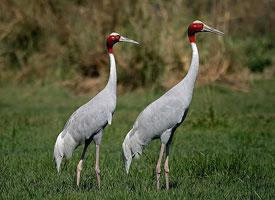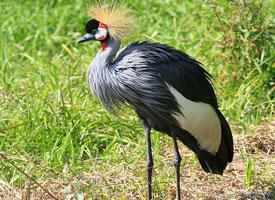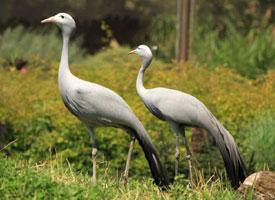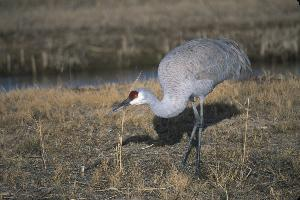
Váhy a míry
| Délka | 200 cm |
|---|---|
| Délka rozpětí křídel | 250 cm |
Stav ohrožení
| Ohrožen |
Popis zvířete
The Sarus crane (Antigone antigone) is a majestic and captivating bird species, renowned for its striking appearance and remarkable behaviors. As the tallest of the flying birds, standing at an impressive height of up to 1.8 meters (5.9 feet), the Sarus crane commands attention with its elegant stature and grace. Its long, slender legs, which are typically a shade of reddish-pink, contribute to its lofty height, while its long neck and large body are covered in a primarily grey plumage, adding to its distinguished look.One of the most distinctive features of the Sarus crane is its vivid red head and upper neck. The intense coloration is a stark contrast to its grey feathers and is devoid of any feathering, which accentuates its striking facial features, including its sharp, pointed beak and penetrating eyes. This vibrant red is complemented by a white crown, adding a touch of elegance to its already regal appearance.
Sarus cranes are known for their lifelong monogamous partnerships, showcasing elaborate courtship displays that are a spectacle to behold. These rituals include a series of synchronized dances, jumps, and calls, which not only strengthen the pair's bond but also mesmerize onlookers. Their call, a loud, trumpeting sound, can be heard over vast distances, serving as a means of communication between the pair and with their offspring.
Found primarily in parts of the Indian Subcontinent, Southeast Asia, and Australia, Sarus cranes inhabit wetlands, marshes, and plains, where they feed on a diet of aquatic plants, insects, and small vertebrates. They are adept at foraging in shallow waters, using their long bills to probe for food. The species plays a crucial role in their ecosystem, acting as a keystone species in maintaining the health and biodiversity of their wetland habitats.
Despite their beauty and ecological importance, Sarus cranes face significant threats from habitat destruction, pollution, and human disturbance, leading to a decline in their population. They are classified as vulnerable by the International Union for Conservation of Nature (IUCN), highlighting the need for concerted conservation efforts to protect these magnificent birds and their habitats.
Breeding season for the Sarus crane is closely tied to the monsoon season, with pairs building large nests in the wetlands. These nests are not just simple structures but elaborate constructions that rise above the water level, providing a safe platform for their eggs. Typically, a pair will lay one to two eggs, which both parents then diligently incubate and protect, demonstrating a strong parental commitment to their offspring.
The Sarus crane's significance extends beyond its ecological role, as it holds a place of cultural importance in many regions. It is revered in various cultures and is often featured in mythology, folklore, and art, symbolizing longevity, fidelity, and love. This cultural reverence further underscores the importance of conserving the Sarus crane, ensuring that it continues to soar across the skies and grace the wetlands of its native regions for generations to come.
Podobná zvířata
Nové fotografie zvířat
Top 10 zvířat
- Chinese water dragon (Physignathus cocincinus)
- Galápagos tortoise (Geochelone nigra complex)
- Dolphin gull (Leucophaeus scoresbii)
- Japanese macaque (Macaca fuscata)
- Colombian red howler (Alouatta seniculus)
- Sea urchins (Echinoidea)
- Diana monkey (Cercopithecus diana)
- Moustached guenon (Cercopithecus cephus)
- Common reed warbler (Acrocephalus scirpaceus)
- Common house mosquito (Culex pipiens)


